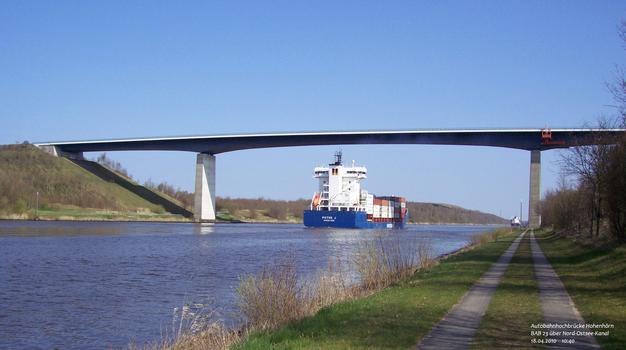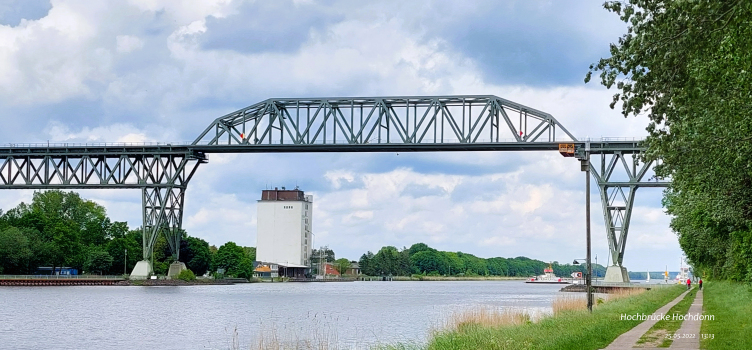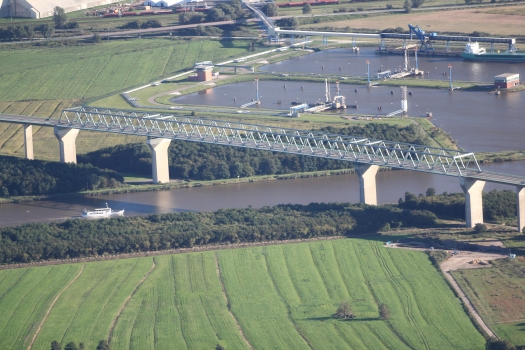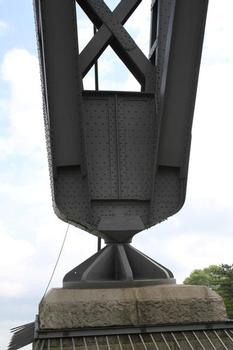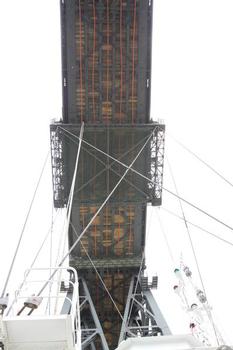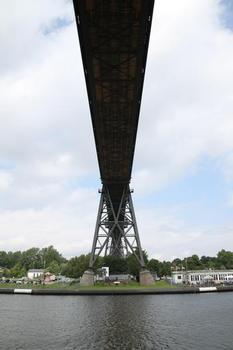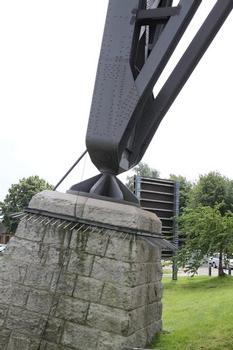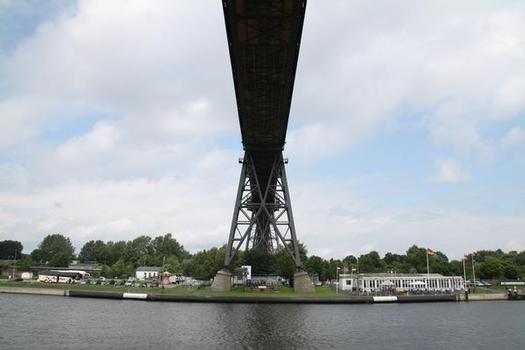General Information
| Other name(s): | Kaiser-Wilhelm-Kanal |
|---|---|
| Beginning of works: | 1887 |
| Completion: | 21 June 1895 |
| Status: | in use |
Project Type
| Function / usage: |
Canal |
|---|
Location
| km | Name |
| 96.588 |
Technical Information
Dimensions
| width | 1895: 66.7 m 1914: 102.5 m 1966: 162.0 m |
|
| length | ca. 100 km |
Cost
| cost of construction | Reichsmark 156 000 000 |
Chronology
| 3 June 1887 | First stone is laid by Emperor Wilhelm I. |
|---|---|
| 1907 — 1914 | Widening of the canal. |
| 16 April 1948 | The Canal is renamed "Nord-Ostsee-Kanal". |
| 1961 | Works for a further widening of the canal begin. |
Excerpt from Wikipedia
The Kiel Canal (German:Nord-Ostsee-Kanal, literally "North-[to]-Baltic Sea canal", formerly known as the Kaiser-Wilhelm-Kanal) is a 95-kilometre (59 mi) long freshwater canal in the German state of Schleswig-Holstein. The canal was finished in 1895, but later widened, and links the North Sea at Brunsbüttel to the Baltic Sea at Kiel-Holtenau. An average of 250 nautical miles (460 km) is saved by using the Kiel Canal instead of going around the Jutland Peninsula. This not only saves time but also avoids storm-prone seas and having to pass through the Sound or Belts.
Besides its two sea entrances, the Kiel Canal is linked, at Oldenbüttel, to the navigable River Eider by the short Gieselau Canal.
History
The first connection between the North and Baltic Seas was constructed while the area was ruled by Denmark-Norway. It was called the Eider Canal, which used stretches of the Eider River for the link between the two seas. Completed during the reign of Christian VII of Denmark in 1784, the Eiderkanal was a 43-kilometre (27 mi) part of a 175-kilometre (109 mi) waterway from Kiel to the Eider River's mouth at Tönning on the west coast. It was only 29 metres (95 ft) wide with a depth of 3 metres (10 ft), which limited the vessels that could use the canal to 300 tonnes.
After 1864 Second Schleswig War put Schleswig-Holstein under the government of Prussia (from 1871 the German Empire), a new canal was sought by merchants and by the German navy, which wanted to link its bases in the Baltic and the North Sea without the need to sail around Denmark.
Construction and expansion
In June 1887, construction started at Holtenau , near Kiel. The canal took over 9,000 workers eight years to build. On 20 June 1895 the canal was officially opened by Kaiser Wilhelm II for transiting from Brunsbüttel to Holtenau. The next day, a ceremony was held in Holtenau, where Wilhelm II named it the Kaiser Wilhelm Kanal (after his grandfather, Kaiser Wilhelm I), and laid the final stone. The opening of the canal was filmed by British director Birt Acres; surviving footage of this early film is preserved in the Science Museum in London. The first Trans-Atlantic sailing ship to pass through the canal was Lilly, commanded by Johan Pitka. Lilly, a barque, was a wooden sailing ship of about 390 tons built 1866 in Sunderland, U.K. She had a length of 127.5 feet (38.9 m), beam 28.7 feet (8.7 m), depth of 17.6 feet (5.4 m) and a 32-foot (9.8 m) keel.
In order to meet the increasing traffic and the demands of the Imperial German Navy, between 1907 and 1914 the canal width was increased. The widening of the canal allowed the passage of a Dreadnought-sized battleship. This meant that these battleships could travel from the Baltic Sea to the North Sea without having to go around Denmark. The enlargement projects were completed by the installation of two larger canal locks in Brunsbüttel and Holtenau.
After World War I
After World War I, the Treaty of Versailles required the canal to be open to vessels of commerce and of war of any nation at peace with Germany, while leaving it under German administration. (The United States opposed this proposal to avoid setting a precedent for similar concessions on the Panama Canal.) The government under Adolf Hitler repudiated its international status in 1936, but the canal was reopened to all traffic after World War II. In 1948, the current name was adopted.
The canal was partially closed in March 2013 after two lock gates failed at the western end near Brunsbüttel. Ships larger than 125 metres (410 ft) were forced to navigate via Skagerrak, a 450-kilometre (280 mi) detour. The failure was blamed on neglect and a lack of funding by the German Federal Government which has been in financial dispute with the state of Schleswig-Holstein regarding the canal. Germany's Transport Ministry promised rapid repairs.
Operation
There are detailed traffic rules for the canal. Each vessel in passage is classified in one of six traffic groups according to its dimensions. Larger ships are obliged to accept pilots and specialised canal helmsmen, in some cases even the assistance of a tugboat. Furthermore, there are regulations regarding the passing of oncoming ships. Larger ships may also be required to moor at the bollards provided at intervals along the canal to allow the passage of oncoming vessels. Special rules apply to pleasure craft.
All permanent, fixed bridges crossing the canal since its construction have a clearance of 42 metres (138 ft).
Maximum length for ships passing the Kiel Canal is 235.50 metres (772.6 ft); with the maximum width (beam) of 32.50 metres (106.6 ft) these ships can have a draught of up to 7.00 metres (22.97 ft). Ships up to a length of 160.00 metres (524.93 ft) may have a draught up to 9.50 metres (31.2 ft). The bulker Ever Leader (deadweight 74001 t) is considered to be the cargo ship that to date has come closest to the overall limits.
Crossings
Several railway lines and federal roads (Autobahnen and Bundesstraßen) cross the canal on eleven fixed links. The bridges have a clearance of 42 metres (138 ft) allowing for ship heights up to 40 metres (130 ft). The oldest bridge still in use is the Levensau High Bridge from 1893; however, the bridge will have to be replaced in the course of a canal expansion already underway. In sequence and in the direction of the official kilometre count from west (Brunsbüttel) to east (Holtenau) these crossings are:
Text imported from Wikipedia article "Kiel Canal" and modified on July 22, 2019 according to the CC-BY-SA 4.0 International license.
Participants
- Friedrich Voß (engineer)
Relevant Web Sites
Relevant Publications
- (1989): Die alten und neuen Holzdalben im Nord-Ostsee-Kanal. In: Bautechnik, v. 66, n. 5 (May 1989), pp. 149-153.
- (2007): Bewertung und Ertüchtigung der Eisenbahnbrücken über den Nord-Ostsee-Kanal. Presented at: 17. Dresdner Brückenbausymposium, Dresden, 13. März 2007.
- (2023): Brücken über den Nord‐Ostsee‐Kanal – Zeugnisse der Baukunst im Spannungsfeld von Erhalt oder Ersatzneubau. In: Stahlbau, v. 92, n. 8 (13 July 2023), pp. 520-535.
- (2020): Field Measurements in the Kiel Canal, Germany: Ship Waves, Drawdown, and Sediment Transport. In: Journal of Waterway, Port, Coastal, and Ocean Engineering, v. 146, n. 4 (July 2020), pp. 04020020.
- (1991): Grossversuch an alten und neuen Holzdalben im Nord-Ostsee-Kanal. In: Bautechnik, v. 68, n. 12 (December 1991), pp. 399-405.
- About this
data sheet - Structure-ID
10000155 - Published on:
16/09/2002 - Last updated on:
24/01/2023

